Christchurch Polytechnic Site Management Portfolio - DMMG600 & BMMG600
VerifiedAdded on 2022/12/26
|26
|5639
|93
Project
AI Summary
This project is a site management portfolio created by a student, focusing on key aspects of construction site operations. It includes a detailed organizational chart outlining roles and responsibilities within a construction company, emphasizing departments like finance, human resources, and project management. The portfolio also examines document control methods, highlighting the importance of communication processes like Building Information Modeling (BIM) in different project stages. Furthermore, it covers site logistics and setup, including efficient allocation of temporary works and site layout considerations. Finally, the project details a waste management plan based on the waste hierarchy, categorizing waste for reduction, reuse, and recycling, with an emphasis on hazardous waste management and environmental compliance. The project is based on a real construction project and includes a project schedule and cost analysis.

Name of student:
Institutional Affiliations:
Name of course:
Institutional Affiliations:
Name of course:
Paraphrase This Document
Need a fresh take? Get an instant paraphrase of this document with our AI Paraphraser
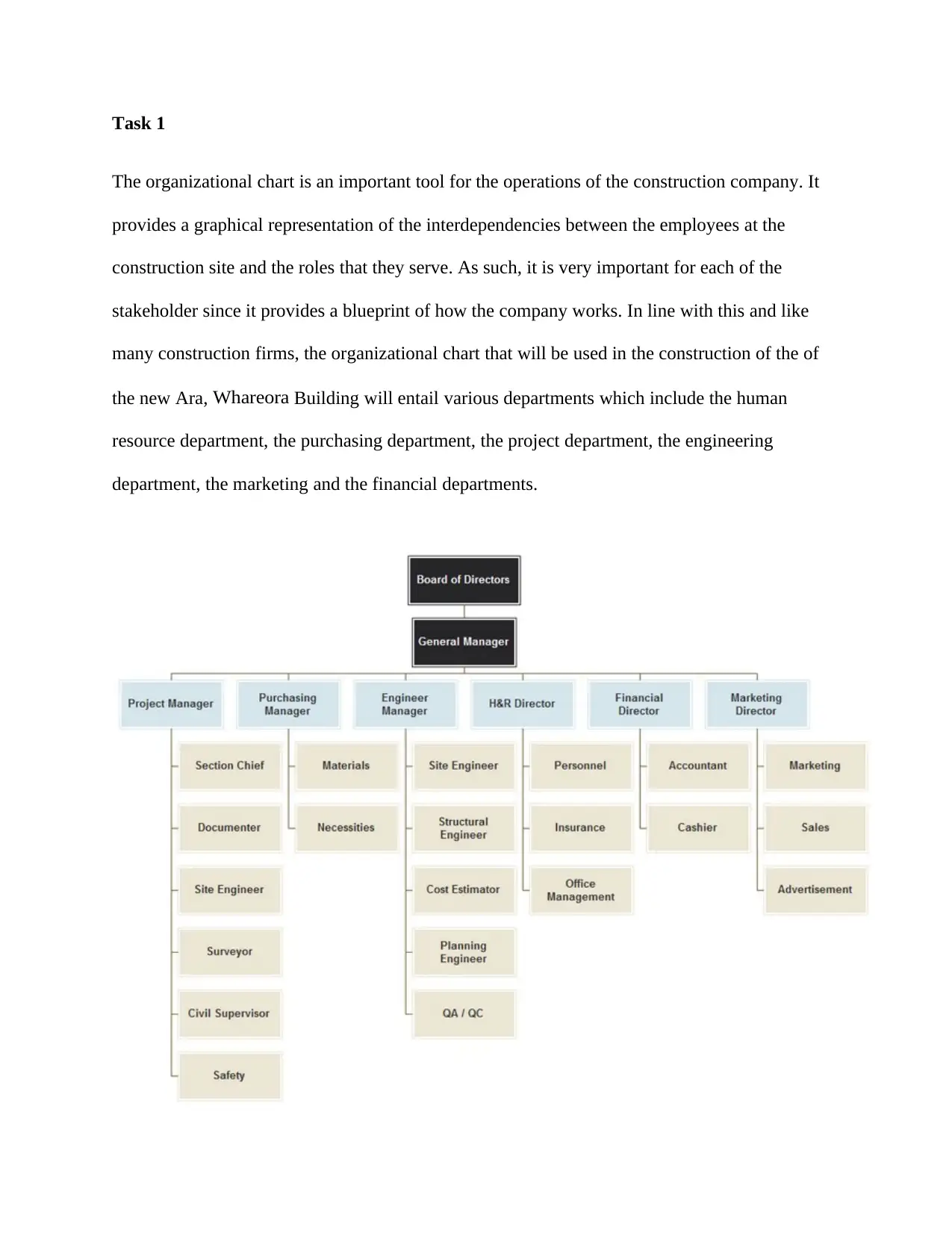
Task 1
The organizational chart is an important tool for the operations of the construction company. It
provides a graphical representation of the interdependencies between the employees at the
construction site and the roles that they serve. As such, it is very important for each of the
stakeholder since it provides a blueprint of how the company works. In line with this and like
many construction firms, the organizational chart that will be used in the construction of the of
the new Ara, Whareora Building will entail various departments which include the human
resource department, the purchasing department, the project department, the engineering
department, the marketing and the financial departments.
The organizational chart is an important tool for the operations of the construction company. It
provides a graphical representation of the interdependencies between the employees at the
construction site and the roles that they serve. As such, it is very important for each of the
stakeholder since it provides a blueprint of how the company works. In line with this and like
many construction firms, the organizational chart that will be used in the construction of the of
the new Ara, Whareora Building will entail various departments which include the human
resource department, the purchasing department, the project department, the engineering
department, the marketing and the financial departments.
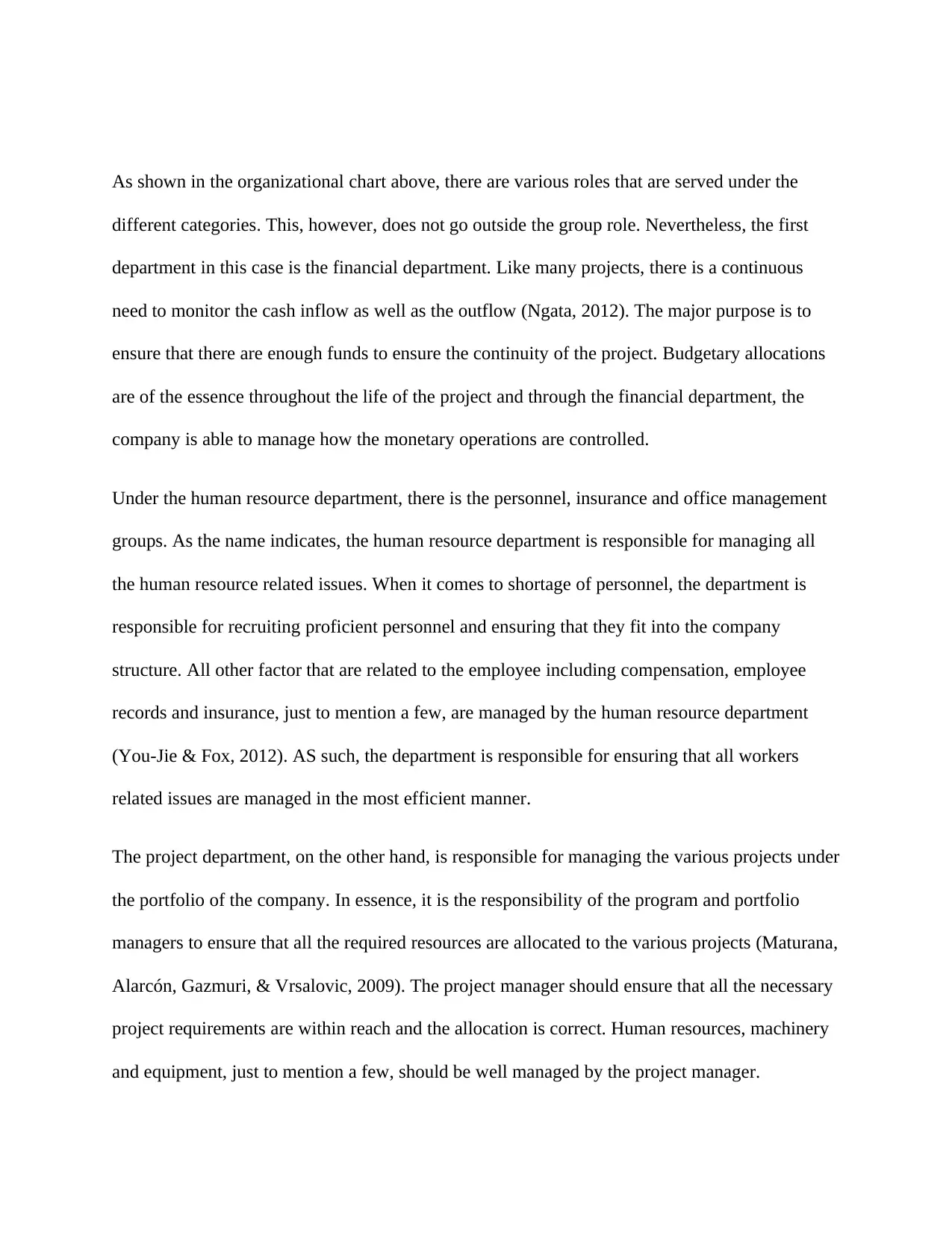
As shown in the organizational chart above, there are various roles that are served under the
different categories. This, however, does not go outside the group role. Nevertheless, the first
department in this case is the financial department. Like many projects, there is a continuous
need to monitor the cash inflow as well as the outflow (Ngata, 2012). The major purpose is to
ensure that there are enough funds to ensure the continuity of the project. Budgetary allocations
are of the essence throughout the life of the project and through the financial department, the
company is able to manage how the monetary operations are controlled.
Under the human resource department, there is the personnel, insurance and office management
groups. As the name indicates, the human resource department is responsible for managing all
the human resource related issues. When it comes to shortage of personnel, the department is
responsible for recruiting proficient personnel and ensuring that they fit into the company
structure. All other factor that are related to the employee including compensation, employee
records and insurance, just to mention a few, are managed by the human resource department
(You-Jie & Fox, 2012). AS such, the department is responsible for ensuring that all workers
related issues are managed in the most efficient manner.
The project department, on the other hand, is responsible for managing the various projects under
the portfolio of the company. In essence, it is the responsibility of the program and portfolio
managers to ensure that all the required resources are allocated to the various projects (Maturana,
Alarcón, Gazmuri, & Vrsalovic, 2009). The project manager should ensure that all the necessary
project requirements are within reach and the allocation is correct. Human resources, machinery
and equipment, just to mention a few, should be well managed by the project manager.
different categories. This, however, does not go outside the group role. Nevertheless, the first
department in this case is the financial department. Like many projects, there is a continuous
need to monitor the cash inflow as well as the outflow (Ngata, 2012). The major purpose is to
ensure that there are enough funds to ensure the continuity of the project. Budgetary allocations
are of the essence throughout the life of the project and through the financial department, the
company is able to manage how the monetary operations are controlled.
Under the human resource department, there is the personnel, insurance and office management
groups. As the name indicates, the human resource department is responsible for managing all
the human resource related issues. When it comes to shortage of personnel, the department is
responsible for recruiting proficient personnel and ensuring that they fit into the company
structure. All other factor that are related to the employee including compensation, employee
records and insurance, just to mention a few, are managed by the human resource department
(You-Jie & Fox, 2012). AS such, the department is responsible for ensuring that all workers
related issues are managed in the most efficient manner.
The project department, on the other hand, is responsible for managing the various projects under
the portfolio of the company. In essence, it is the responsibility of the program and portfolio
managers to ensure that all the required resources are allocated to the various projects (Maturana,
Alarcón, Gazmuri, & Vrsalovic, 2009). The project manager should ensure that all the necessary
project requirements are within reach and the allocation is correct. Human resources, machinery
and equipment, just to mention a few, should be well managed by the project manager.
⊘ This is a preview!⊘
Do you want full access?
Subscribe today to unlock all pages.

Trusted by 1+ million students worldwide
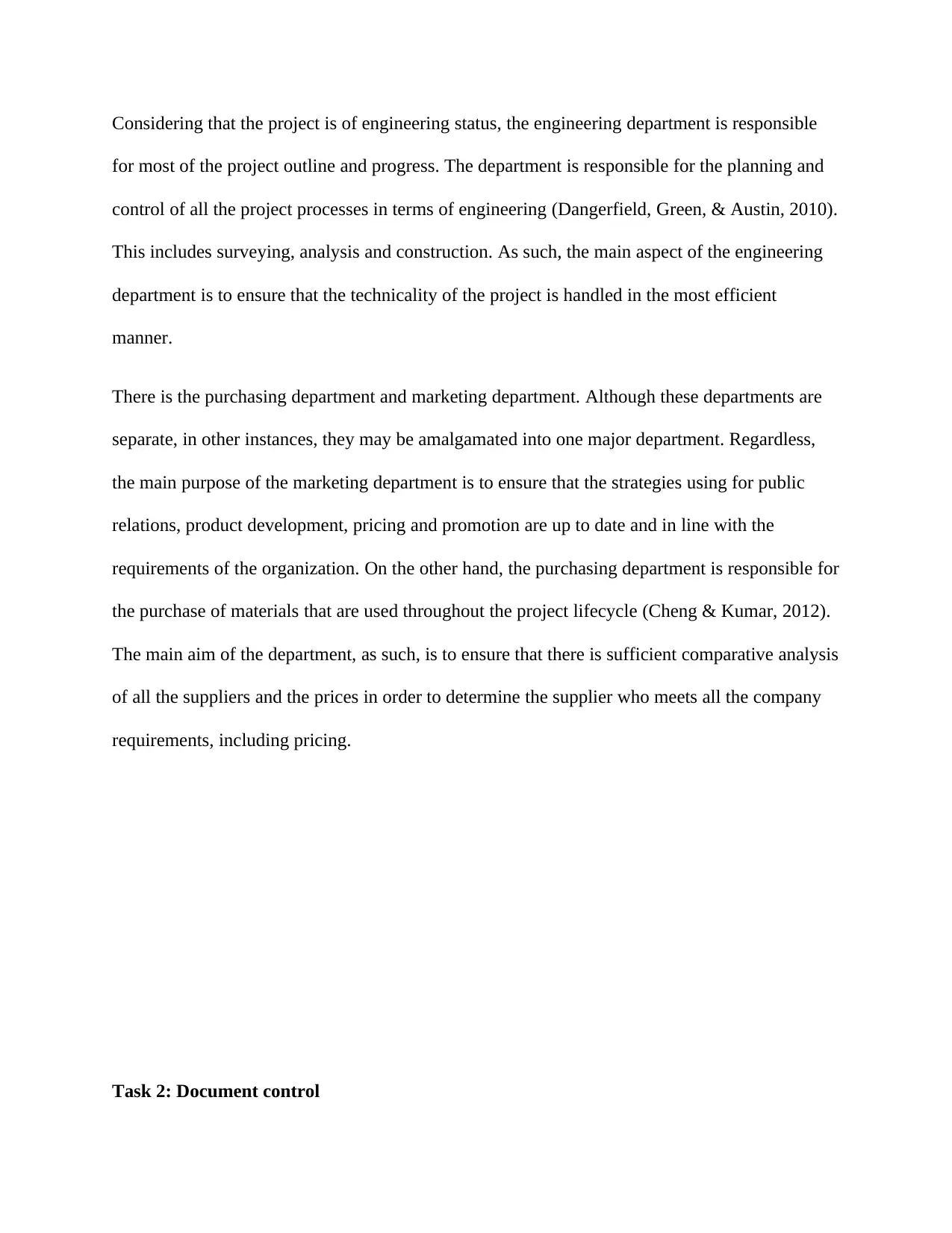
Considering that the project is of engineering status, the engineering department is responsible
for most of the project outline and progress. The department is responsible for the planning and
control of all the project processes in terms of engineering (Dangerfield, Green, & Austin, 2010).
This includes surveying, analysis and construction. As such, the main aspect of the engineering
department is to ensure that the technicality of the project is handled in the most efficient
manner.
There is the purchasing department and marketing department. Although these departments are
separate, in other instances, they may be amalgamated into one major department. Regardless,
the main purpose of the marketing department is to ensure that the strategies using for public
relations, product development, pricing and promotion are up to date and in line with the
requirements of the organization. On the other hand, the purchasing department is responsible for
the purchase of materials that are used throughout the project lifecycle (Cheng & Kumar, 2012).
The main aim of the department, as such, is to ensure that there is sufficient comparative analysis
of all the suppliers and the prices in order to determine the supplier who meets all the company
requirements, including pricing.
Task 2: Document control
for most of the project outline and progress. The department is responsible for the planning and
control of all the project processes in terms of engineering (Dangerfield, Green, & Austin, 2010).
This includes surveying, analysis and construction. As such, the main aspect of the engineering
department is to ensure that the technicality of the project is handled in the most efficient
manner.
There is the purchasing department and marketing department. Although these departments are
separate, in other instances, they may be amalgamated into one major department. Regardless,
the main purpose of the marketing department is to ensure that the strategies using for public
relations, product development, pricing and promotion are up to date and in line with the
requirements of the organization. On the other hand, the purchasing department is responsible for
the purchase of materials that are used throughout the project lifecycle (Cheng & Kumar, 2012).
The main aim of the department, as such, is to ensure that there is sufficient comparative analysis
of all the suppliers and the prices in order to determine the supplier who meets all the company
requirements, including pricing.
Task 2: Document control
Paraphrase This Document
Need a fresh take? Get an instant paraphrase of this document with our AI Paraphraser
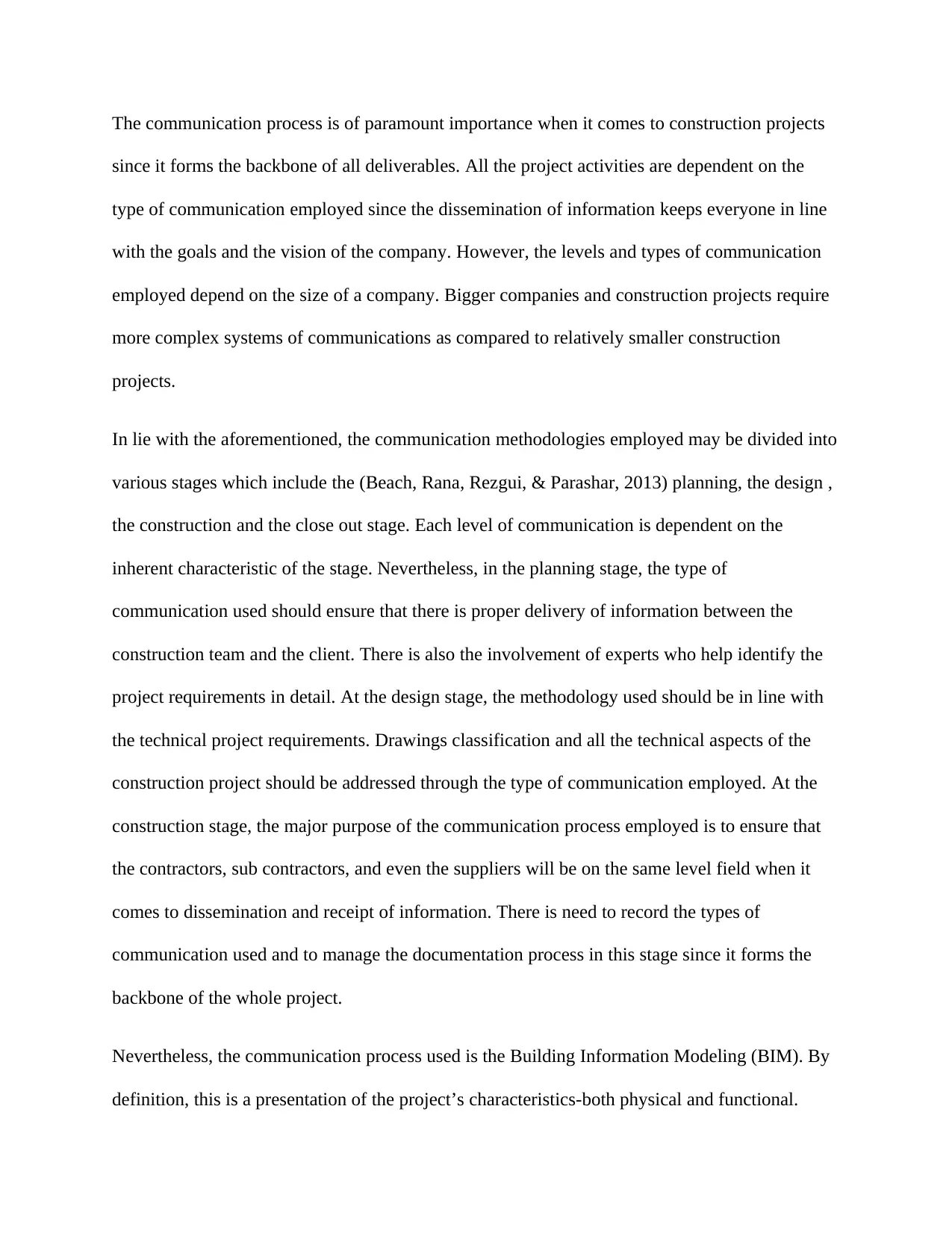
The communication process is of paramount importance when it comes to construction projects
since it forms the backbone of all deliverables. All the project activities are dependent on the
type of communication employed since the dissemination of information keeps everyone in line
with the goals and the vision of the company. However, the levels and types of communication
employed depend on the size of a company. Bigger companies and construction projects require
more complex systems of communications as compared to relatively smaller construction
projects.
In lie with the aforementioned, the communication methodologies employed may be divided into
various stages which include the (Beach, Rana, Rezgui, & Parashar, 2013) planning, the design ,
the construction and the close out stage. Each level of communication is dependent on the
inherent characteristic of the stage. Nevertheless, in the planning stage, the type of
communication used should ensure that there is proper delivery of information between the
construction team and the client. There is also the involvement of experts who help identify the
project requirements in detail. At the design stage, the methodology used should be in line with
the technical project requirements. Drawings classification and all the technical aspects of the
construction project should be addressed through the type of communication employed. At the
construction stage, the major purpose of the communication process employed is to ensure that
the contractors, sub contractors, and even the suppliers will be on the same level field when it
comes to dissemination and receipt of information. There is need to record the types of
communication used and to manage the documentation process in this stage since it forms the
backbone of the whole project.
Nevertheless, the communication process used is the Building Information Modeling (BIM). By
definition, this is a presentation of the project’s characteristics-both physical and functional.
since it forms the backbone of all deliverables. All the project activities are dependent on the
type of communication employed since the dissemination of information keeps everyone in line
with the goals and the vision of the company. However, the levels and types of communication
employed depend on the size of a company. Bigger companies and construction projects require
more complex systems of communications as compared to relatively smaller construction
projects.
In lie with the aforementioned, the communication methodologies employed may be divided into
various stages which include the (Beach, Rana, Rezgui, & Parashar, 2013) planning, the design ,
the construction and the close out stage. Each level of communication is dependent on the
inherent characteristic of the stage. Nevertheless, in the planning stage, the type of
communication used should ensure that there is proper delivery of information between the
construction team and the client. There is also the involvement of experts who help identify the
project requirements in detail. At the design stage, the methodology used should be in line with
the technical project requirements. Drawings classification and all the technical aspects of the
construction project should be addressed through the type of communication employed. At the
construction stage, the major purpose of the communication process employed is to ensure that
the contractors, sub contractors, and even the suppliers will be on the same level field when it
comes to dissemination and receipt of information. There is need to record the types of
communication used and to manage the documentation process in this stage since it forms the
backbone of the whole project.
Nevertheless, the communication process used is the Building Information Modeling (BIM). By
definition, this is a presentation of the project’s characteristics-both physical and functional.
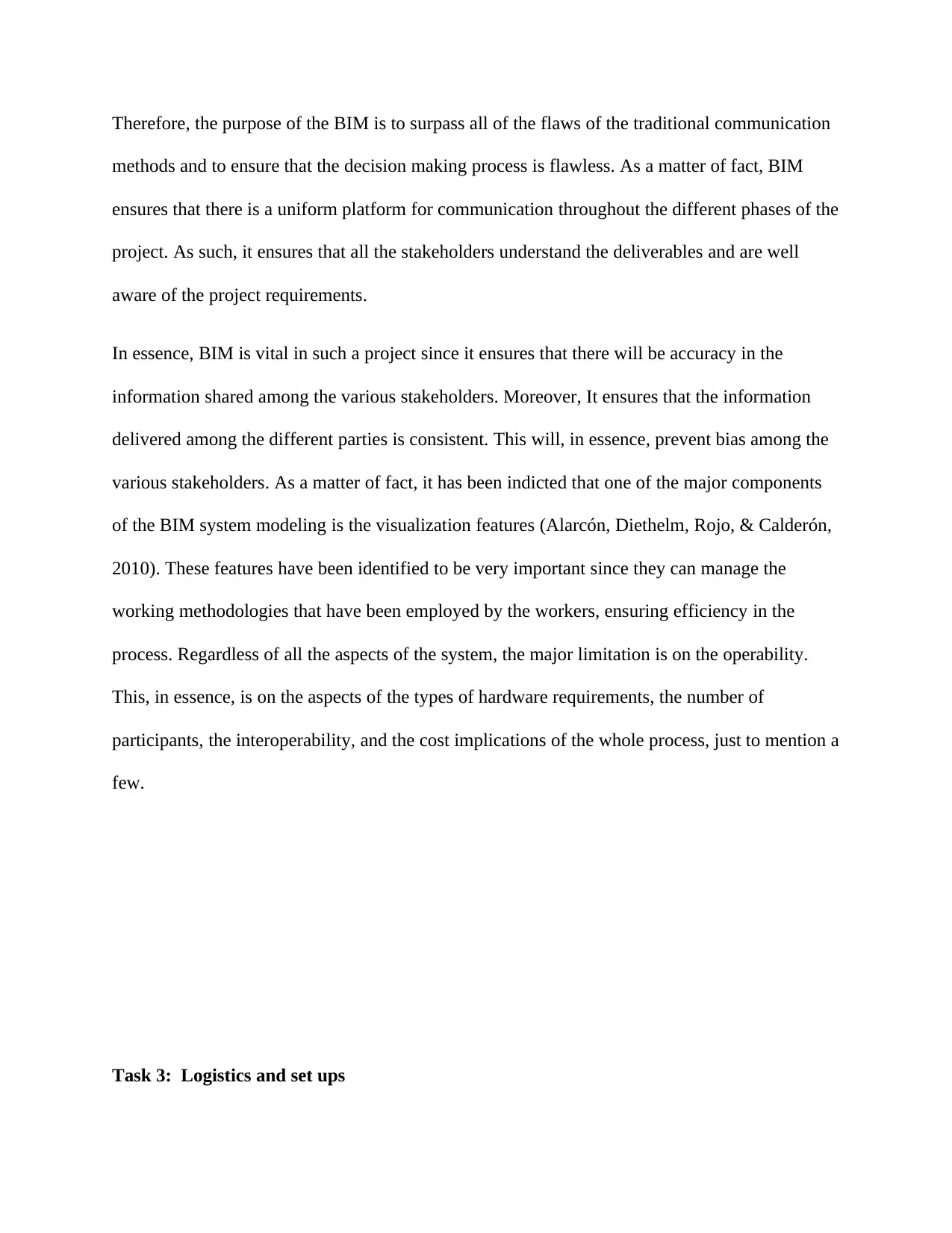
Therefore, the purpose of the BIM is to surpass all of the flaws of the traditional communication
methods and to ensure that the decision making process is flawless. As a matter of fact, BIM
ensures that there is a uniform platform for communication throughout the different phases of the
project. As such, it ensures that all the stakeholders understand the deliverables and are well
aware of the project requirements.
In essence, BIM is vital in such a project since it ensures that there will be accuracy in the
information shared among the various stakeholders. Moreover, It ensures that the information
delivered among the different parties is consistent. This will, in essence, prevent bias among the
various stakeholders. As a matter of fact, it has been indicted that one of the major components
of the BIM system modeling is the visualization features (Alarcón, Diethelm, Rojo, & Calderón,
2010). These features have been identified to be very important since they can manage the
working methodologies that have been employed by the workers, ensuring efficiency in the
process. Regardless of all the aspects of the system, the major limitation is on the operability.
This, in essence, is on the aspects of the types of hardware requirements, the number of
participants, the interoperability, and the cost implications of the whole process, just to mention a
few.
Task 3: Logistics and set ups
methods and to ensure that the decision making process is flawless. As a matter of fact, BIM
ensures that there is a uniform platform for communication throughout the different phases of the
project. As such, it ensures that all the stakeholders understand the deliverables and are well
aware of the project requirements.
In essence, BIM is vital in such a project since it ensures that there will be accuracy in the
information shared among the various stakeholders. Moreover, It ensures that the information
delivered among the different parties is consistent. This will, in essence, prevent bias among the
various stakeholders. As a matter of fact, it has been indicted that one of the major components
of the BIM system modeling is the visualization features (Alarcón, Diethelm, Rojo, & Calderón,
2010). These features have been identified to be very important since they can manage the
working methodologies that have been employed by the workers, ensuring efficiency in the
process. Regardless of all the aspects of the system, the major limitation is on the operability.
This, in essence, is on the aspects of the types of hardware requirements, the number of
participants, the interoperability, and the cost implications of the whole process, just to mention a
few.
Task 3: Logistics and set ups
⊘ This is a preview!⊘
Do you want full access?
Subscribe today to unlock all pages.

Trusted by 1+ million students worldwide
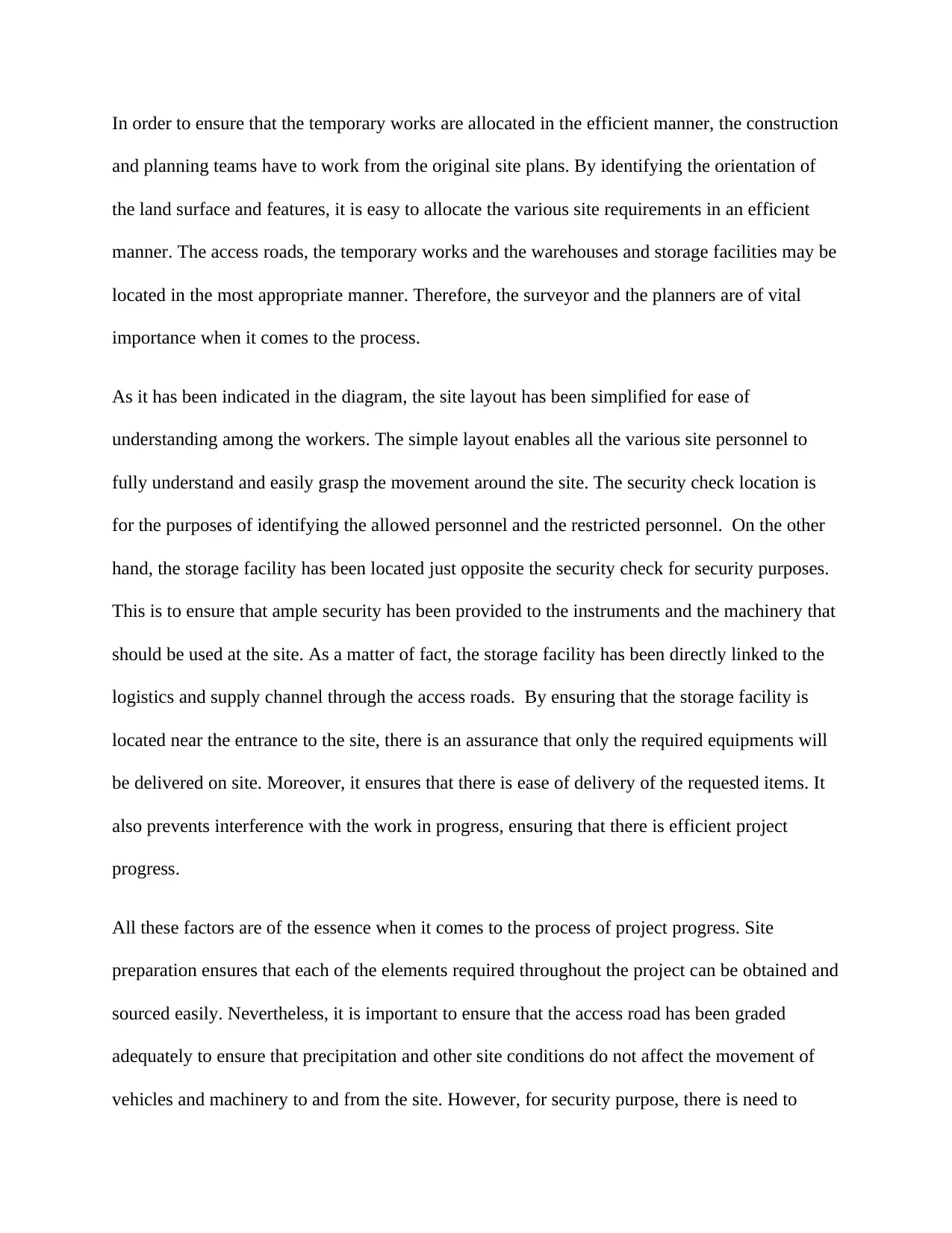
In order to ensure that the temporary works are allocated in the efficient manner, the construction
and planning teams have to work from the original site plans. By identifying the orientation of
the land surface and features, it is easy to allocate the various site requirements in an efficient
manner. The access roads, the temporary works and the warehouses and storage facilities may be
located in the most appropriate manner. Therefore, the surveyor and the planners are of vital
importance when it comes to the process.
As it has been indicated in the diagram, the site layout has been simplified for ease of
understanding among the workers. The simple layout enables all the various site personnel to
fully understand and easily grasp the movement around the site. The security check location is
for the purposes of identifying the allowed personnel and the restricted personnel. On the other
hand, the storage facility has been located just opposite the security check for security purposes.
This is to ensure that ample security has been provided to the instruments and the machinery that
should be used at the site. As a matter of fact, the storage facility has been directly linked to the
logistics and supply channel through the access roads. By ensuring that the storage facility is
located near the entrance to the site, there is an assurance that only the required equipments will
be delivered on site. Moreover, it ensures that there is ease of delivery of the requested items. It
also prevents interference with the work in progress, ensuring that there is efficient project
progress.
All these factors are of the essence when it comes to the process of project progress. Site
preparation ensures that each of the elements required throughout the project can be obtained and
sourced easily. Nevertheless, it is important to ensure that the access road has been graded
adequately to ensure that precipitation and other site conditions do not affect the movement of
vehicles and machinery to and from the site. However, for security purpose, there is need to
and planning teams have to work from the original site plans. By identifying the orientation of
the land surface and features, it is easy to allocate the various site requirements in an efficient
manner. The access roads, the temporary works and the warehouses and storage facilities may be
located in the most appropriate manner. Therefore, the surveyor and the planners are of vital
importance when it comes to the process.
As it has been indicated in the diagram, the site layout has been simplified for ease of
understanding among the workers. The simple layout enables all the various site personnel to
fully understand and easily grasp the movement around the site. The security check location is
for the purposes of identifying the allowed personnel and the restricted personnel. On the other
hand, the storage facility has been located just opposite the security check for security purposes.
This is to ensure that ample security has been provided to the instruments and the machinery that
should be used at the site. As a matter of fact, the storage facility has been directly linked to the
logistics and supply channel through the access roads. By ensuring that the storage facility is
located near the entrance to the site, there is an assurance that only the required equipments will
be delivered on site. Moreover, it ensures that there is ease of delivery of the requested items. It
also prevents interference with the work in progress, ensuring that there is efficient project
progress.
All these factors are of the essence when it comes to the process of project progress. Site
preparation ensures that each of the elements required throughout the project can be obtained and
sourced easily. Nevertheless, it is important to ensure that the access road has been graded
adequately to ensure that precipitation and other site conditions do not affect the movement of
vehicles and machinery to and from the site. However, for security purpose, there is need to
Paraphrase This Document
Need a fresh take? Get an instant paraphrase of this document with our AI Paraphraser
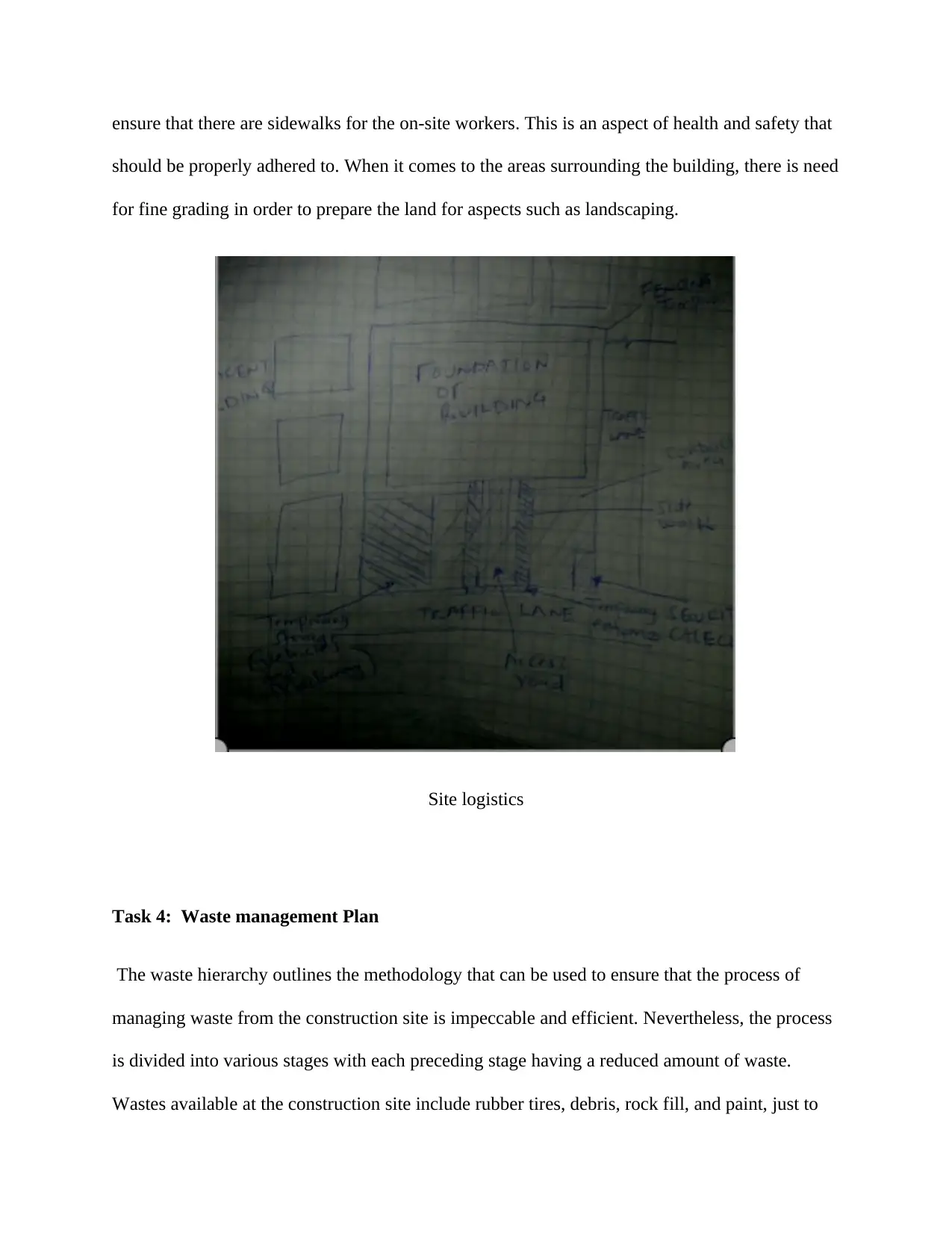
ensure that there are sidewalks for the on-site workers. This is an aspect of health and safety that
should be properly adhered to. When it comes to the areas surrounding the building, there is need
for fine grading in order to prepare the land for aspects such as landscaping.
Site logistics
Task 4: Waste management Plan
The waste hierarchy outlines the methodology that can be used to ensure that the process of
managing waste from the construction site is impeccable and efficient. Nevertheless, the process
is divided into various stages with each preceding stage having a reduced amount of waste.
Wastes available at the construction site include rubber tires, debris, rock fill, and paint, just to
should be properly adhered to. When it comes to the areas surrounding the building, there is need
for fine grading in order to prepare the land for aspects such as landscaping.
Site logistics
Task 4: Waste management Plan
The waste hierarchy outlines the methodology that can be used to ensure that the process of
managing waste from the construction site is impeccable and efficient. Nevertheless, the process
is divided into various stages with each preceding stage having a reduced amount of waste.
Wastes available at the construction site include rubber tires, debris, rock fill, and paint, just to
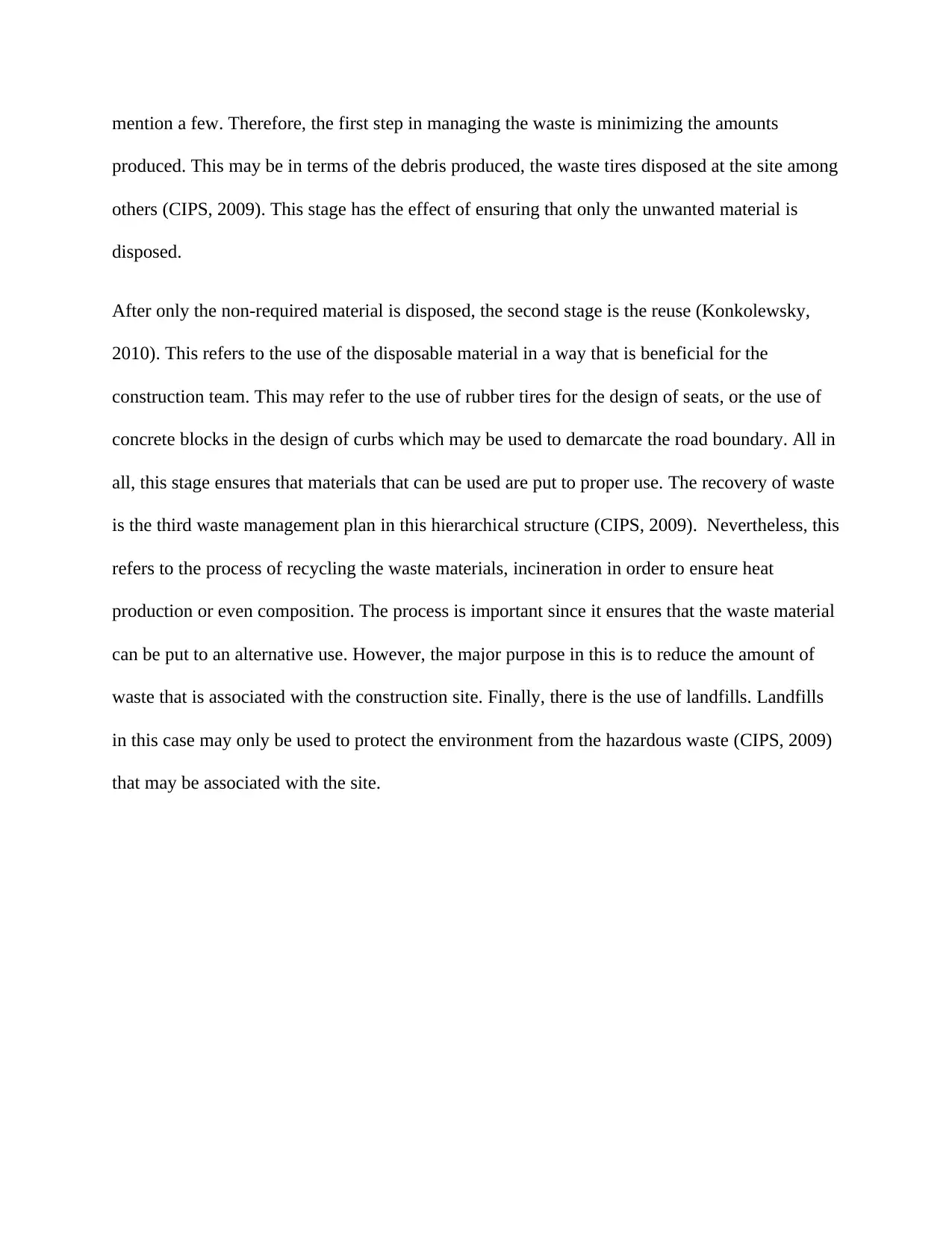
mention a few. Therefore, the first step in managing the waste is minimizing the amounts
produced. This may be in terms of the debris produced, the waste tires disposed at the site among
others (CIPS, 2009). This stage has the effect of ensuring that only the unwanted material is
disposed.
After only the non-required material is disposed, the second stage is the reuse (Konkolewsky,
2010). This refers to the use of the disposable material in a way that is beneficial for the
construction team. This may refer to the use of rubber tires for the design of seats, or the use of
concrete blocks in the design of curbs which may be used to demarcate the road boundary. All in
all, this stage ensures that materials that can be used are put to proper use. The recovery of waste
is the third waste management plan in this hierarchical structure (CIPS, 2009). Nevertheless, this
refers to the process of recycling the waste materials, incineration in order to ensure heat
production or even composition. The process is important since it ensures that the waste material
can be put to an alternative use. However, the major purpose in this is to reduce the amount of
waste that is associated with the construction site. Finally, there is the use of landfills. Landfills
in this case may only be used to protect the environment from the hazardous waste (CIPS, 2009)
that may be associated with the site.
produced. This may be in terms of the debris produced, the waste tires disposed at the site among
others (CIPS, 2009). This stage has the effect of ensuring that only the unwanted material is
disposed.
After only the non-required material is disposed, the second stage is the reuse (Konkolewsky,
2010). This refers to the use of the disposable material in a way that is beneficial for the
construction team. This may refer to the use of rubber tires for the design of seats, or the use of
concrete blocks in the design of curbs which may be used to demarcate the road boundary. All in
all, this stage ensures that materials that can be used are put to proper use. The recovery of waste
is the third waste management plan in this hierarchical structure (CIPS, 2009). Nevertheless, this
refers to the process of recycling the waste materials, incineration in order to ensure heat
production or even composition. The process is important since it ensures that the waste material
can be put to an alternative use. However, the major purpose in this is to reduce the amount of
waste that is associated with the construction site. Finally, there is the use of landfills. Landfills
in this case may only be used to protect the environment from the hazardous waste (CIPS, 2009)
that may be associated with the site.
⊘ This is a preview!⊘
Do you want full access?
Subscribe today to unlock all pages.

Trusted by 1+ million students worldwide
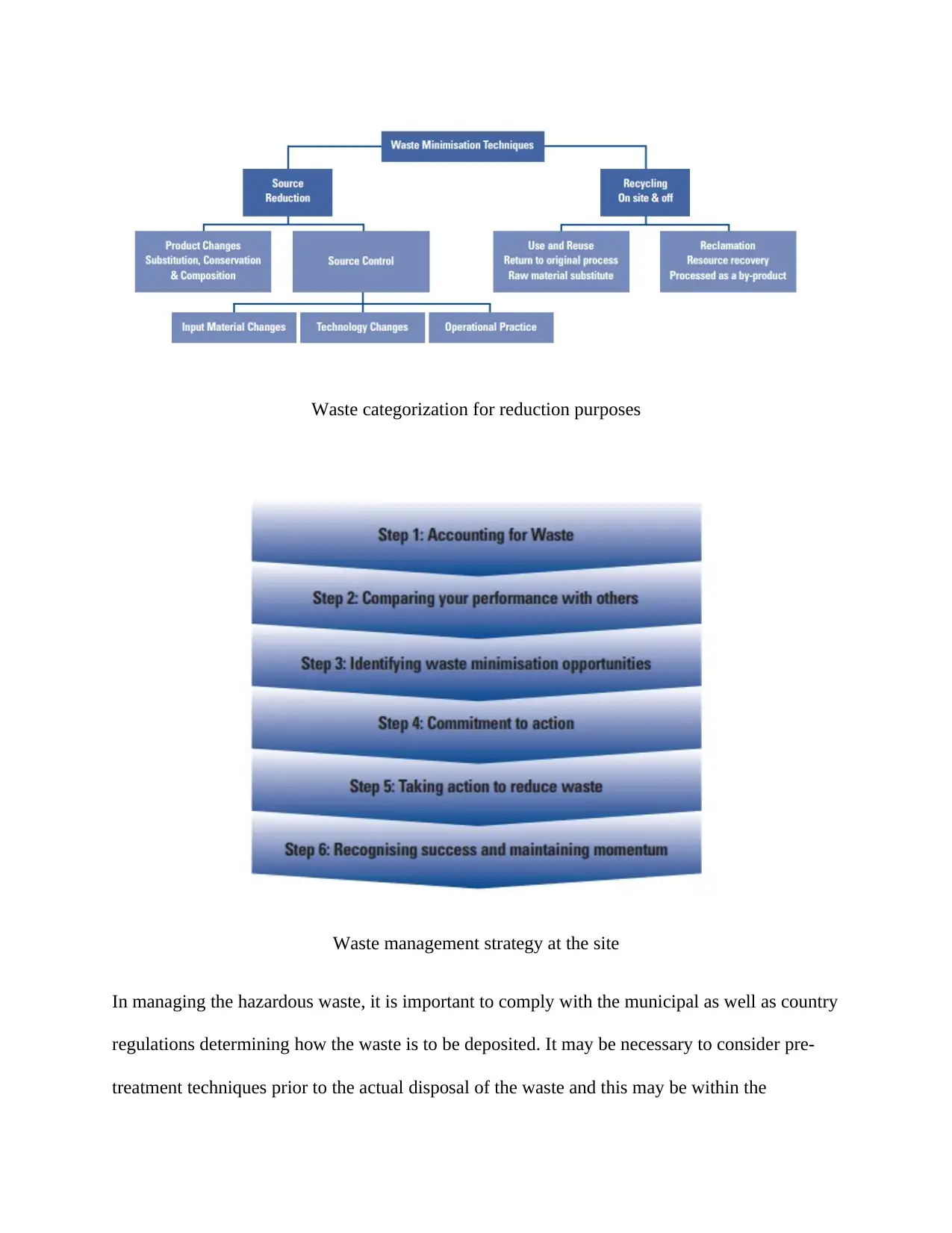
Waste categorization for reduction purposes
Waste management strategy at the site
In managing the hazardous waste, it is important to comply with the municipal as well as country
regulations determining how the waste is to be deposited. It may be necessary to consider pre-
treatment techniques prior to the actual disposal of the waste and this may be within the
Waste management strategy at the site
In managing the hazardous waste, it is important to comply with the municipal as well as country
regulations determining how the waste is to be deposited. It may be necessary to consider pre-
treatment techniques prior to the actual disposal of the waste and this may be within the
Paraphrase This Document
Need a fresh take? Get an instant paraphrase of this document with our AI Paraphraser
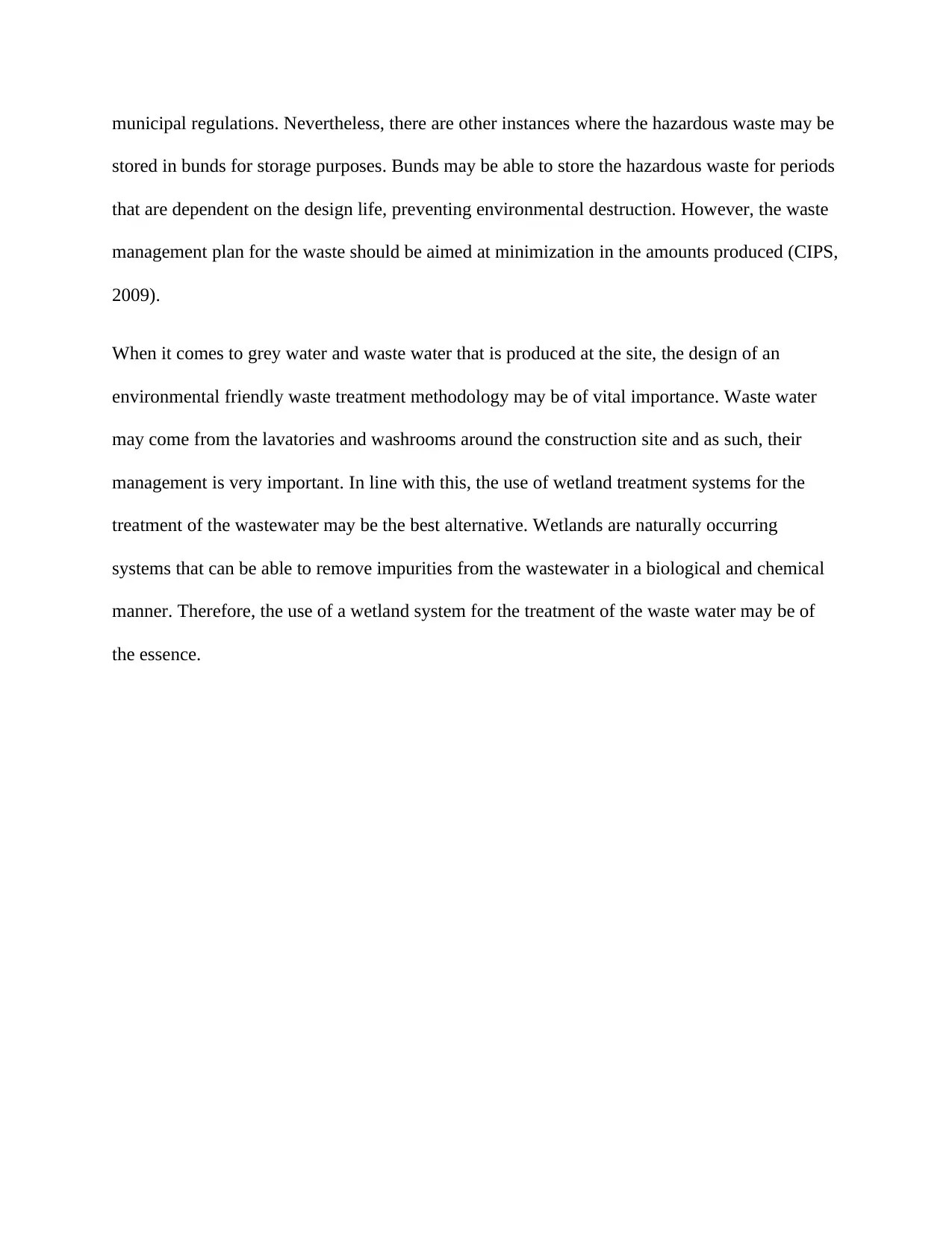
municipal regulations. Nevertheless, there are other instances where the hazardous waste may be
stored in bunds for storage purposes. Bunds may be able to store the hazardous waste for periods
that are dependent on the design life, preventing environmental destruction. However, the waste
management plan for the waste should be aimed at minimization in the amounts produced (CIPS,
2009).
When it comes to grey water and waste water that is produced at the site, the design of an
environmental friendly waste treatment methodology may be of vital importance. Waste water
may come from the lavatories and washrooms around the construction site and as such, their
management is very important. In line with this, the use of wetland treatment systems for the
treatment of the wastewater may be the best alternative. Wetlands are naturally occurring
systems that can be able to remove impurities from the wastewater in a biological and chemical
manner. Therefore, the use of a wetland system for the treatment of the waste water may be of
the essence.
stored in bunds for storage purposes. Bunds may be able to store the hazardous waste for periods
that are dependent on the design life, preventing environmental destruction. However, the waste
management plan for the waste should be aimed at minimization in the amounts produced (CIPS,
2009).
When it comes to grey water and waste water that is produced at the site, the design of an
environmental friendly waste treatment methodology may be of vital importance. Waste water
may come from the lavatories and washrooms around the construction site and as such, their
management is very important. In line with this, the use of wetland treatment systems for the
treatment of the wastewater may be the best alternative. Wetlands are naturally occurring
systems that can be able to remove impurities from the wastewater in a biological and chemical
manner. Therefore, the use of a wetland system for the treatment of the waste water may be of
the essence.
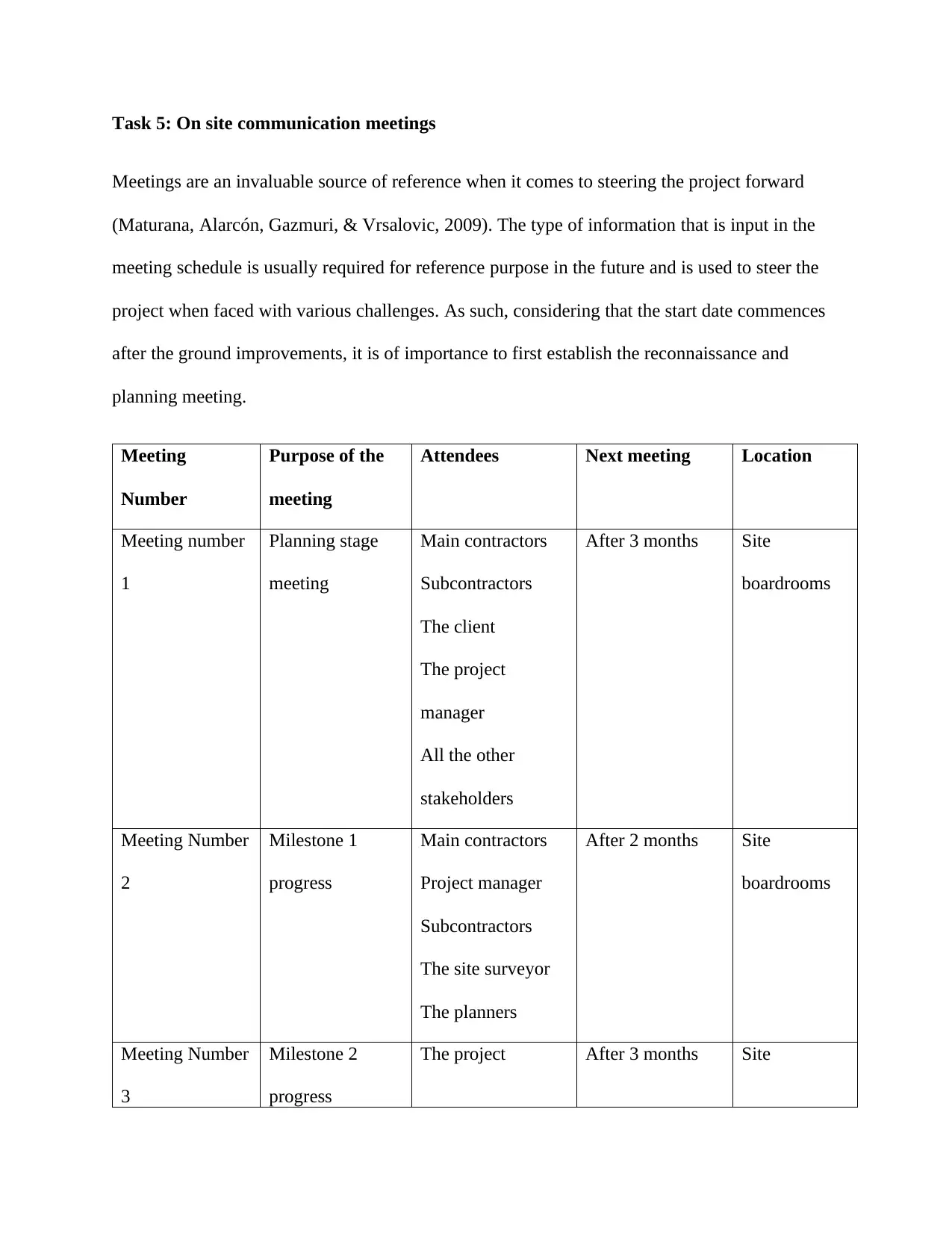
Task 5: On site communication meetings
Meetings are an invaluable source of reference when it comes to steering the project forward
(Maturana, Alarcón, Gazmuri, & Vrsalovic, 2009). The type of information that is input in the
meeting schedule is usually required for reference purpose in the future and is used to steer the
project when faced with various challenges. As such, considering that the start date commences
after the ground improvements, it is of importance to first establish the reconnaissance and
planning meeting.
Meeting
Number
Purpose of the
meeting
Attendees Next meeting Location
Meeting number
1
Planning stage
meeting
Main contractors
Subcontractors
The client
The project
manager
All the other
stakeholders
After 3 months Site
boardrooms
Meeting Number
2
Milestone 1
progress
Main contractors
Project manager
Subcontractors
The site surveyor
The planners
After 2 months Site
boardrooms
Meeting Number
3
Milestone 2
progress
The project After 3 months Site
Meetings are an invaluable source of reference when it comes to steering the project forward
(Maturana, Alarcón, Gazmuri, & Vrsalovic, 2009). The type of information that is input in the
meeting schedule is usually required for reference purpose in the future and is used to steer the
project when faced with various challenges. As such, considering that the start date commences
after the ground improvements, it is of importance to first establish the reconnaissance and
planning meeting.
Meeting
Number
Purpose of the
meeting
Attendees Next meeting Location
Meeting number
1
Planning stage
meeting
Main contractors
Subcontractors
The client
The project
manager
All the other
stakeholders
After 3 months Site
boardrooms
Meeting Number
2
Milestone 1
progress
Main contractors
Project manager
Subcontractors
The site surveyor
The planners
After 2 months Site
boardrooms
Meeting Number
3
Milestone 2
progress
The project After 3 months Site
⊘ This is a preview!⊘
Do you want full access?
Subscribe today to unlock all pages.

Trusted by 1+ million students worldwide
1 out of 26
Related Documents
Your All-in-One AI-Powered Toolkit for Academic Success.
+13062052269
info@desklib.com
Available 24*7 on WhatsApp / Email
![[object Object]](/_next/static/media/star-bottom.7253800d.svg)
Unlock your academic potential
Copyright © 2020–2025 A2Z Services. All Rights Reserved. Developed and managed by ZUCOL.





